SC Wall-to-RC Basemat Over-Strength Connection: Behavior and Design
Abstract
:1. Introduction
2. Previous Research
2.1. SC Wall-to-RC Basemat Non-Contact Lap Splice
2.2. SC Wall-to-RC Basemat Full-Strength Connection
3. Experimental Program
3.1. Specimen Design and Expected Behavior
3.2. Test Specimens
3.3. Material Properties
3.4. Test Setup and Loading Protocol
3.5. Instrumentation
4. Test Results
4.1. Specimen SCRC1
4.2. Specimen SCRC2
4.3. Comparison to Full-Strength Connection
5. Finite Element Models and Analyses
5.1. Details of the Finite Element Models
5.2. Parametric Studies
6. Summary and Conclusions
- SC walls with overstrength connections with lap spliced rebars had better deformation (drift) capacity as compared to SC walls with full-strength connections.
- Tests conducted on SC walls with overstrength connections showed that the connections failed when the rebar dowels ruptured in axial tension at relatively large displacements.
- The lateral load capacity of SC walls with overstrength connections was governed by the flexural capacity of the cross-section of the RC portion of walls, MnRC.
- The initial stiffness of the SC walls with overstrength connections reduced from the linear (proportional) limit before the peak load, but the deformation (drift) capacity was still higher than SC walls with full-strength connections.
- SC walls with overstrength connections reached their lateral load capacities at drift ratios of 1.4% and 1.7%, whereas SC walls with full-strength connections reached their lateral load capacity at lower drift ratios of 0.9%.
- The results of the parametric studies showed that SC walls with overstrength connections develop lateral load capacities corresponding to the in-plane flexural capacities MnRC of the RC cross-sections at the base of the walls.
- The lateral load capacities of the walls decrease and the effects of in-plane shear forces become less influential with increasing aspect ratios.
- Parametric studies showed that the thickness of the wall does not have a significant influence on the lateral load capacity of SC walls with overstrength connection (within practical limits).
Author Contributions
Funding
Institutional Review Board Statement
Informed Consent Statement
Data Availability Statement
Acknowledgments
Conflicts of Interest
References
- Kanchi, M.; Kitano, T.; Sugawara, R.; Hirakawa, K. Experimental Study on A Concrete Filled Steel Structure Part 2 Compressive Tests (1). In Summary of Technical Papers of Annual Meeting, Architectural Institute of Japan, Structures; Japanese Architectural Society: Tokyo, Japan, 1996; pp. 1071–1072. (In Japanese) [Google Scholar]
- Usami, S.; Akiyama, H.; Narikawa, M.; Hara, K.; Takeuchi, M.; Sasaki, N. Study on a Concrete Filled Steel Structure for Nuclear Plants (Part 2). Compressive Loading Tests on Wall Members. In Proceedings of the Transactions of the 13th Structural Mechanics in Reactor Technology (SMiRT-13), Porto Alegre, Brazil, 13–18 August 1995; pp. 21–26. [Google Scholar]
- Zhang, K.; Varma, A.H.; Malushte, S.; Gallocher, S. Effects of Shear Connectors on the Local Buckling and Composite Action in Steel Concrete Composite Walls. Nucl. Eng. Des. 2014, 269, 231–239. [Google Scholar] [CrossRef]
- Zhang, K.; Seo, J.; Varma, A.H. Steel-Plate Composite Walls: Local Buckling and Design for Axial Compression. ASCE J. Struct. Eng. 2020, 146, 04020044. [Google Scholar] [CrossRef]
- Funakoshi, A.; Akita, S.; Matsumoto, T.; Hara, K.; Matsuo, I.; Hayashi, N. Experimental study on a concrete filled steel structure: Part 7: Bending shear tests (Outline of the experimental program and the results). In Summary of Technical Papers of Annual Meeting, Architectural Institute of Japan, Structures II; Japanese Architectural Society: Tokyo, Japan, 1997; pp. 1063–1064. [Google Scholar]
- Kitano, T.; Akita, S.; Nakazawa, M.; Fujino, Y.; Ohta, H.; Yamaguchi, T.; Nakayama, T. Experimental study on a concrete-filled steel structure Part 4: Shear tests (outline of the experimental program and the results). In Summary of Technical Papers of Annual Meeting, Vol. B-2. Architectural Institute of Japan; Japanese Architectural Society: Tokyo, Japan, 1997; pp. 1057–1058. [Google Scholar]
- Kurt, E.G.; Varma, A.H.; Booth, P.N.; Whittaker, A. In-plane Behavior and Design of Rectangular SC Wall Piers without Boundary Elements. ASCE J. Struct. Eng. 2016, 142, 04016026. [Google Scholar] [CrossRef]
- Ozaki, M.; Akita, S.; Oosuga, H.; Nakayama, T.; Adachi, N. Study on steel plate reinforced concrete panels subjected to cyclic in-plane shear. Nucl. Eng. Des. 2004, 228, 225–244. [Google Scholar] [CrossRef]
- Seo, J.; Varma, A.H.; Sener, K.; Ayhan, D. Steel-Plate Composite (SC) Walls: In-Plane Shear Behavior, Database, and Design. J. Constr. Steel Res. 2016, 119, 202–215. [Google Scholar] [CrossRef]
- Varma, A.H.; Zhang, K.; Chi, H.; Booth, P.N.; Baker, T. In-plane shear behavior of SC composite walls: Theory vs. experiment. In Proceedings of the 21st International Conference on Structural Mechanics in Reactor Technology (SMiRT 21), New Delhi, India, 6–11 November 2011. [Google Scholar]
- Booth, P.N.; Bhardwaj, S.R.; Tseng, T.C.; Seo, J.; Varma, A.H. Ultimate shear strength of steel-plate composite (SC) walls with boundary elements. J. Constr. Steel Res. 2020, 165, 105810. [Google Scholar] [CrossRef]
- Vecchio, F.J.; McQuade, I. Towards Improved Modeling of Steel-Concrete Composite Wall Elements. J. Nucl. Eng. Des. 2011, 241, 2629–2642. [Google Scholar] [CrossRef]
- Hrynyk, T.D.; Vecchio, F.J. Capturing Out-of-Plane Shear Failures in the Analysis of Reinforced Concrete Shells. ASCE J. Struct. Eng. 2015, 141, 04015058. [Google Scholar] [CrossRef] [Green Version]
- Sener, K.; Varma, A.H. Steel-Plate Composite SC Walls: Experimental Database and Design for Out-of-Plane Shear. J. Constr. Steel Res. 2014, 100, 197–210. [Google Scholar] [CrossRef]
- Sener, K.; Varma, A.H.; Seo, J. Experimental and Numerical Investigations of the Shear Behavior of Steel-Plate Composite (SC) Beams without Shear Reinforcement. Eng. Struct. 2016, 127, 495–509. [Google Scholar] [CrossRef]
- Sener, K.; Varma, A.H.; Ayhan, D. Steel-Plate Composite SC Walls: Out-of-Plane Flexural Behavior, Database, and Design. J. Constr. Steel Res. 2015, 108, 46–59. [Google Scholar] [CrossRef]
- Varma, A.H.; Malushte, S.R.; Sener, K.; Booth, P.N.; Coogler, K. Steel-Plate Composite Walls: Analysis and Design Including Thermal Effects. In Proceedings of the Transactions of the 21st International Conference on Structural Mechanics in Reactor Technology (SMiRT21), New Delhi, India, 6–11 November 2011. [Google Scholar]
- Varma, A.; Malushte, S.R.; Sener, K.C.; Lai, Z. Steel-plate composite (SC) walls for safety related nuclear facilities: Design for in-plane forces and out-of-plane moments. Nucl. Eng. Des. 2014, 269, 240–249. [Google Scholar] [CrossRef]
- AISC N690-18; Specification for Safety-Related Steel Structures for Nuclear Facilities. AISC: Chicago, IL, USA, 2018.
- Seo, J.; Varma, A.H. Experimental behavior and design of steel plate composite-to-reinforced concrete lap splice connections. J. Struct. Eng. 2017, 143, 04017011. [Google Scholar] [CrossRef]
- Katayama, S.; Fujita, F.; Furuwada, M.; Shohara, R.; Takeuchi, M.; Matsumoto, R. Experimental study on a steel plate reinforced concrete structure (part #33). Pull-out tests on anchorage rebars of SC panels. In Summaries of Technical Papers of Annual Meeting, Architectural Institute of Japan, B-2, Structures II, Structural Dynamics Nuclear Power Plants; Japanese Architectural Society: Tokyo, Japan, 1999; pp. 1247–1248. [Google Scholar]
- Epackachi, S.; Whittaker, A.; Varma, A.H.; Kurt, E. Finite Element Modeling of Steel-Plate Concrete Composite Wall Piers. Eng. Struct. 2015, 100, 369–384. [Google Scholar] [CrossRef]
- Bhardwaj, S.; Varma, A.H.; Orbovic, N. Behavior of Steel-Plate Composite Wall Piers under Biaxial Loading. J. Struct. Eng. 2019, 145, 04018252. [Google Scholar] [CrossRef]
- Bhardwaj, S.; Sener, K.C.; Varma, A.H. Multi-Hazard Investigation and Testing of Composite (SC) Wall Piers: Seismic and Thermal Loads. Nucl. Eng. Des. 2019, 348, 121–130. [Google Scholar] [CrossRef] [Green Version]
- ACI 318M-14; Building Code Requirements for Structural Concrete and Commentary (Metric). ACI: Farmington Hills, MI, USA, 2014.
- ACI 349M-13; Code Requirements for Nuclear Safety-Related Concrete Structures and Commentary (Metric). ACI: Farmington Hills, MI, USA, 2013.
- ASTM E8 E8M-13a; Test Methods for Tension Testing of Metallic Materials. ASTM: Conshohocken, PA, USA, 2013.
- ASTM C39 C39M; Standard Test Method for Compressive Strength Test of Cylindrical Concrete Specimens. ASTM: Conshohocken, PA, USA, 2013.
- ATC-24; Guidelines for Cyclic Seismic Testing of Components of Steel Structures. ATC: Redwood City, CA, USA, 1992.
- Bentz, E.C. Explaining the Riddle of Tension Stiffening Models for Shear Panel Experiments. ASCE J. Struct. Eng. 2005, 131, 1422–1425. [Google Scholar] [CrossRef]


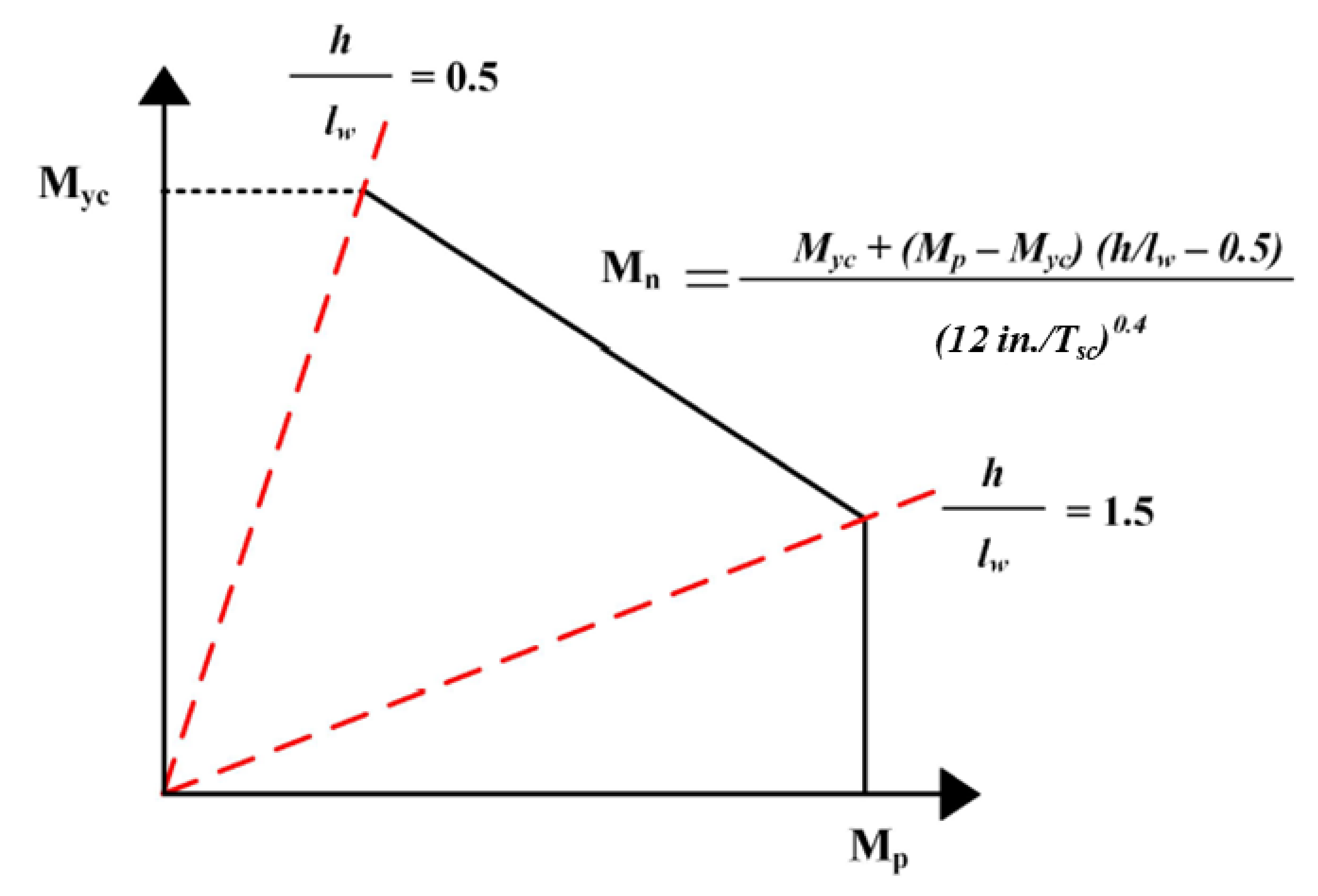



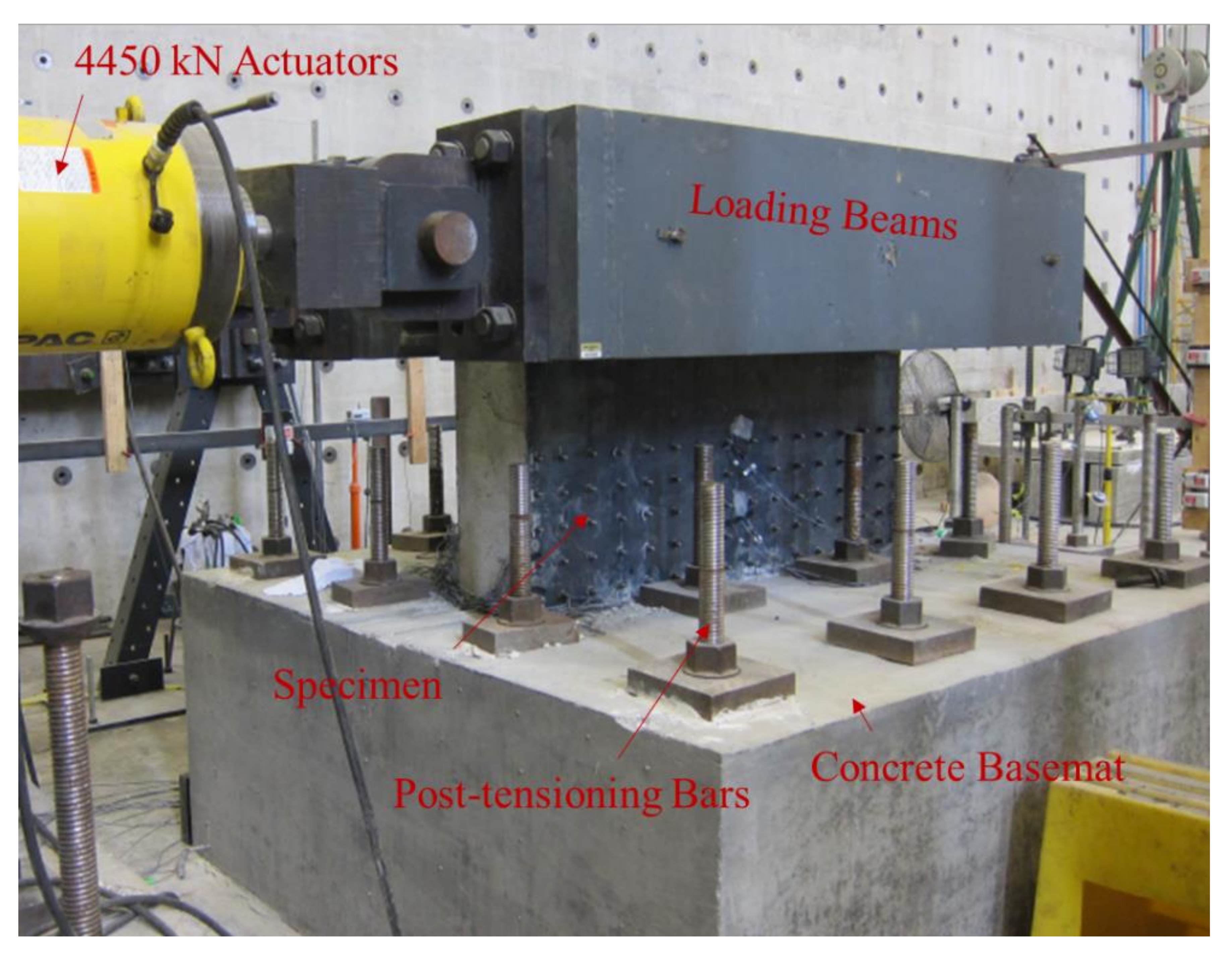
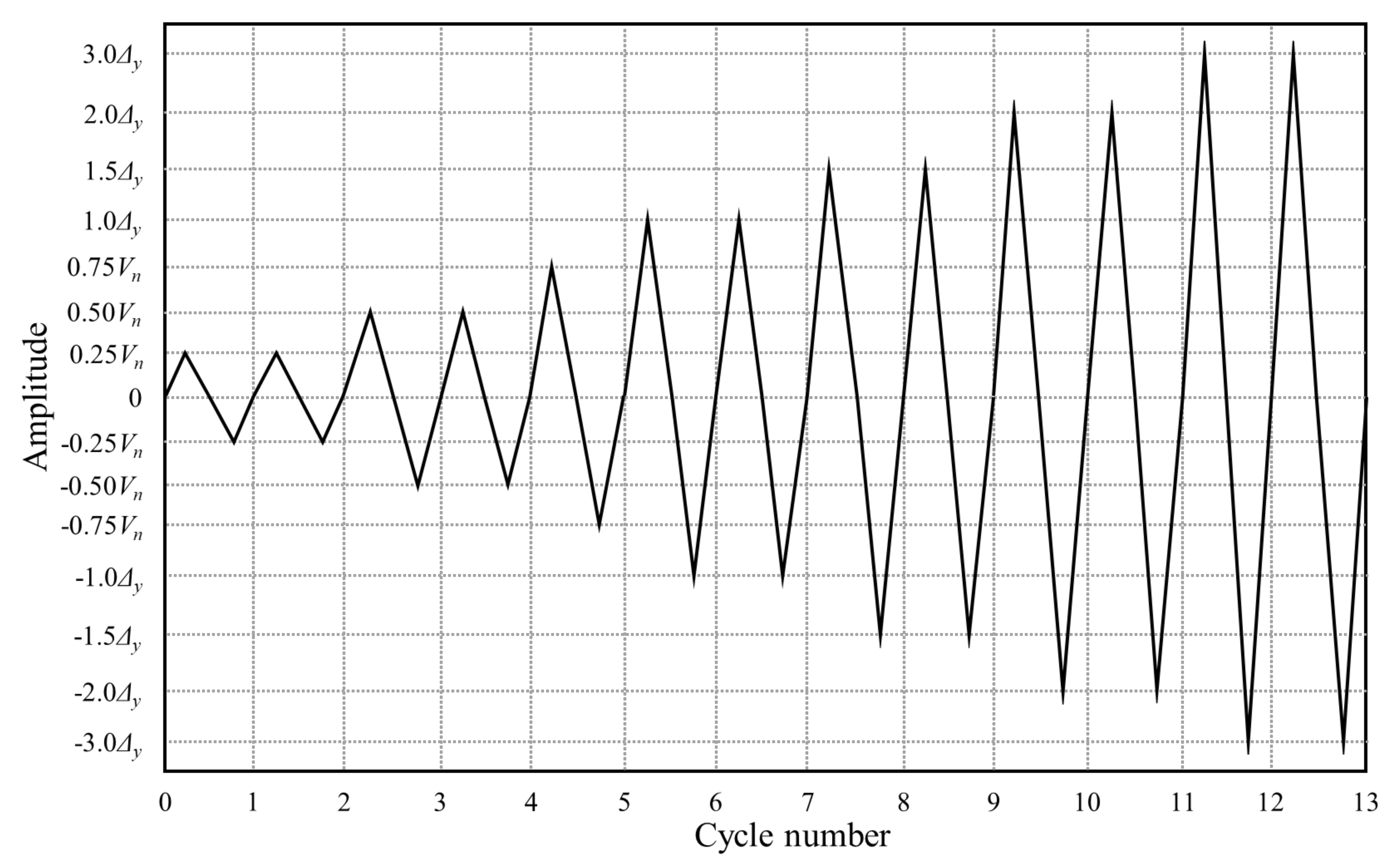
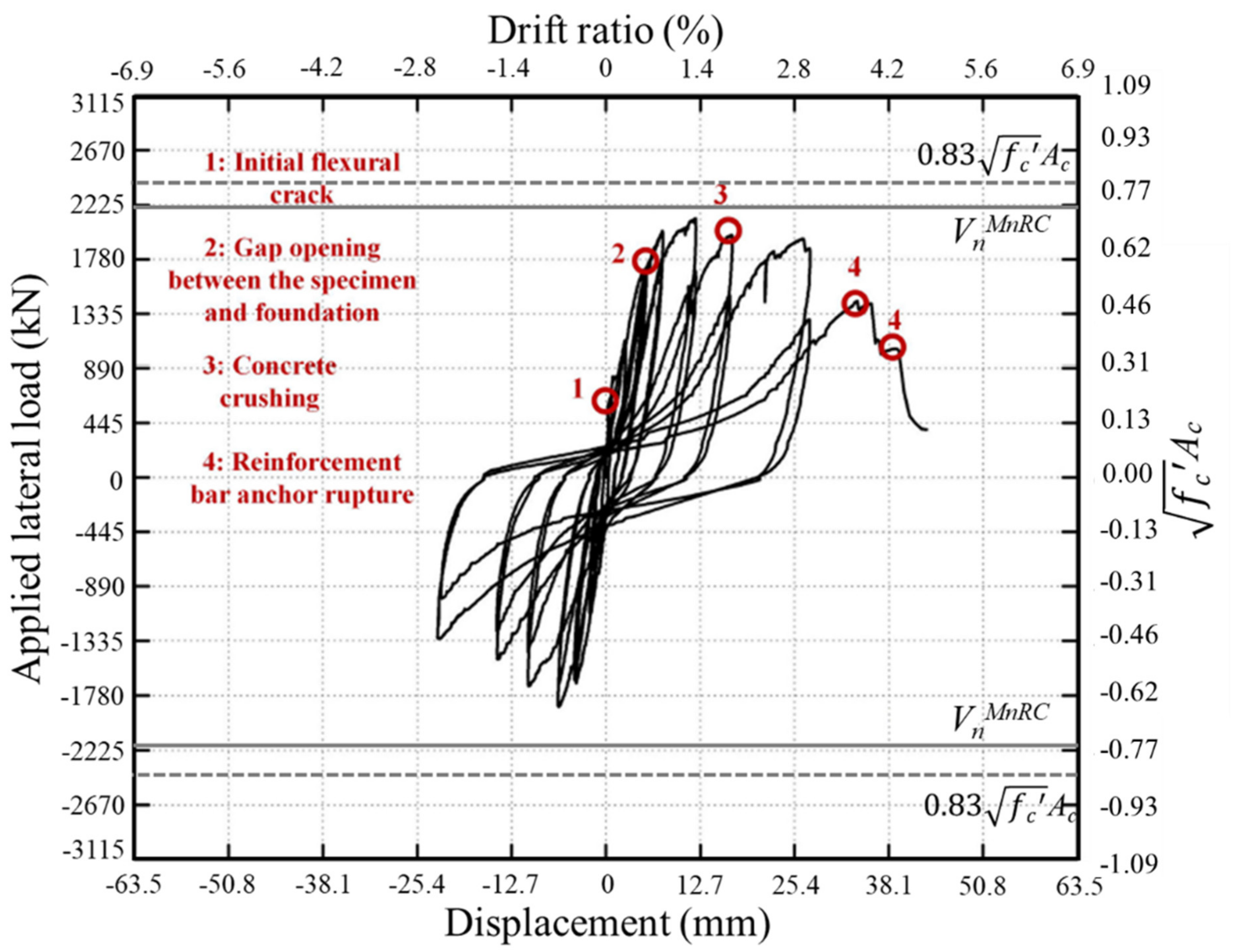
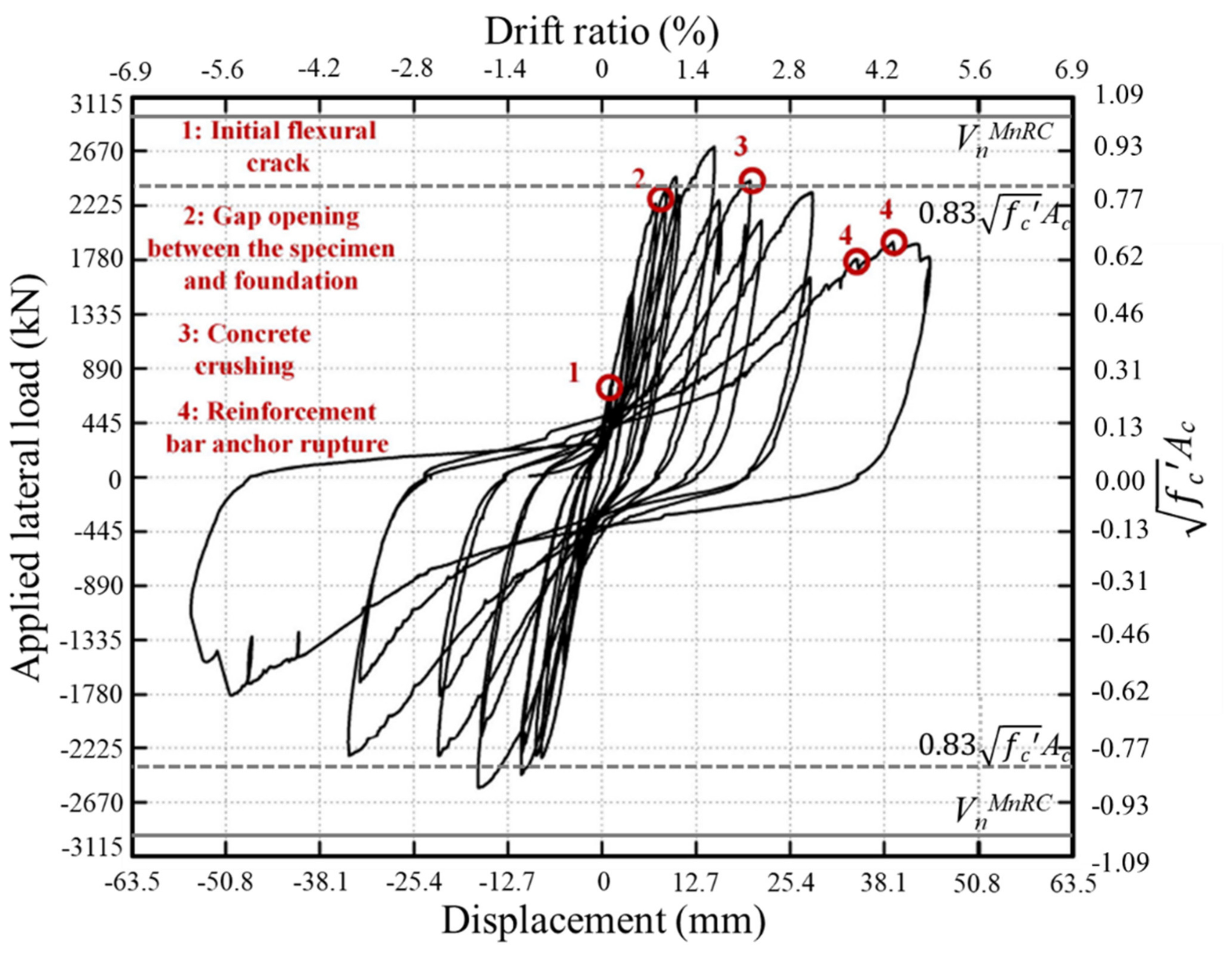


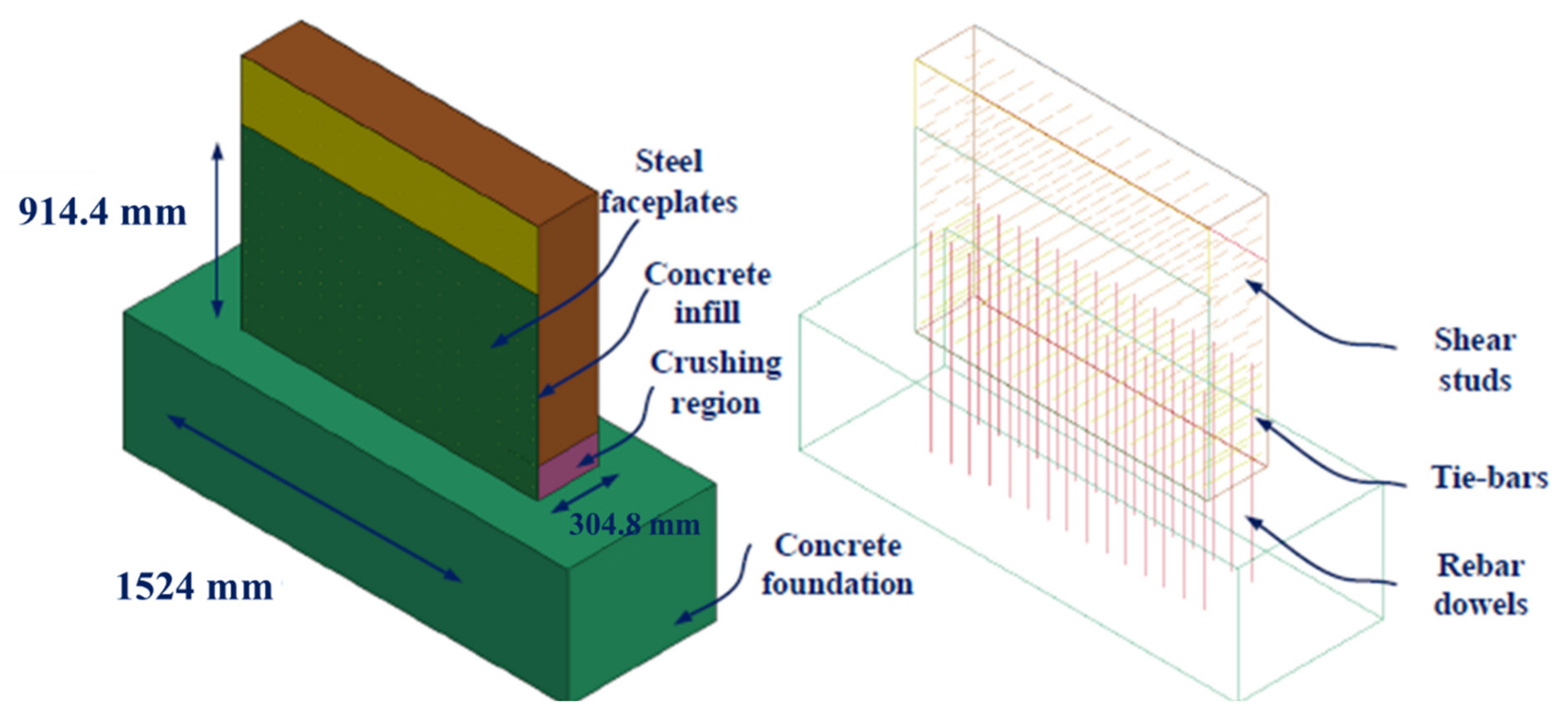
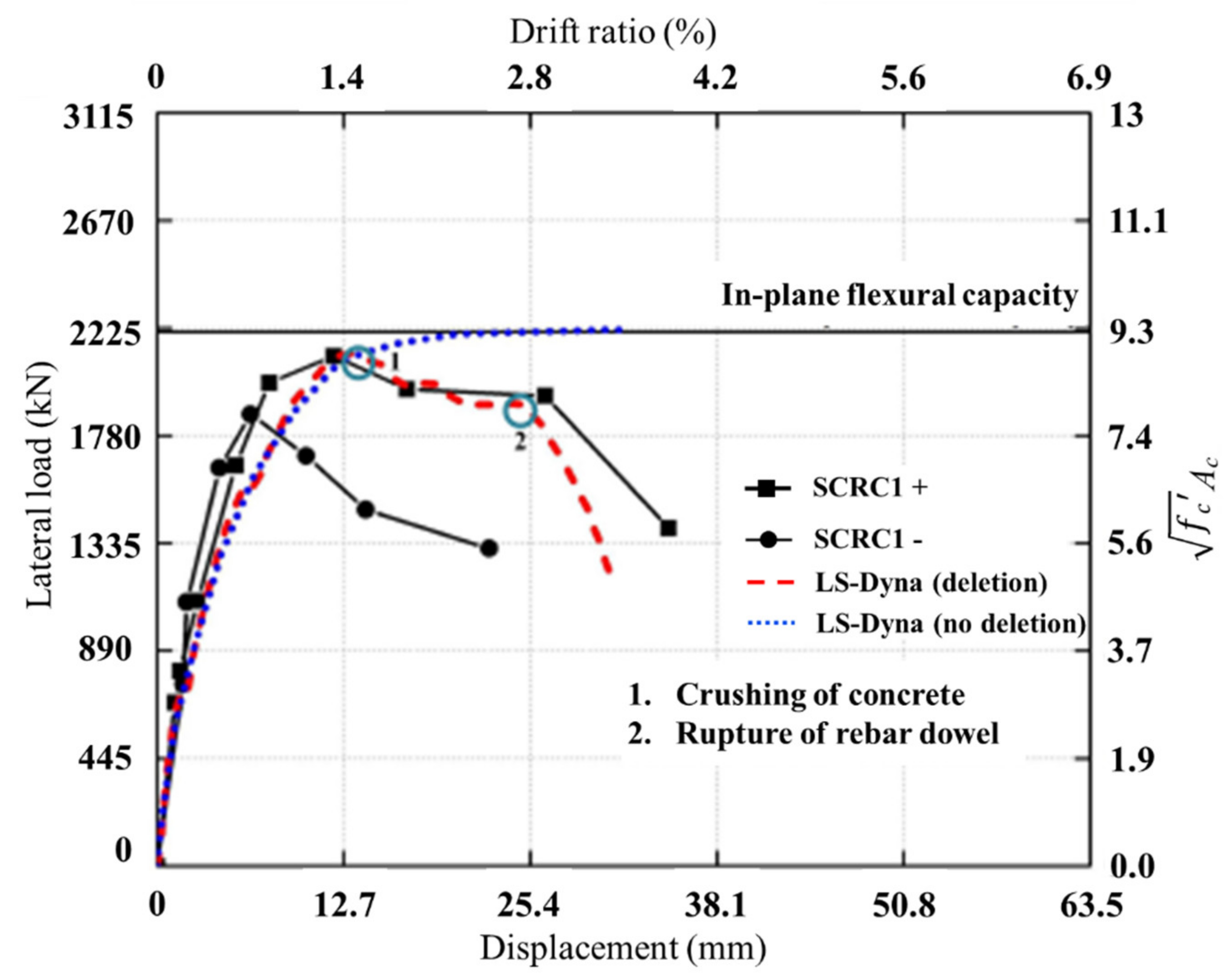

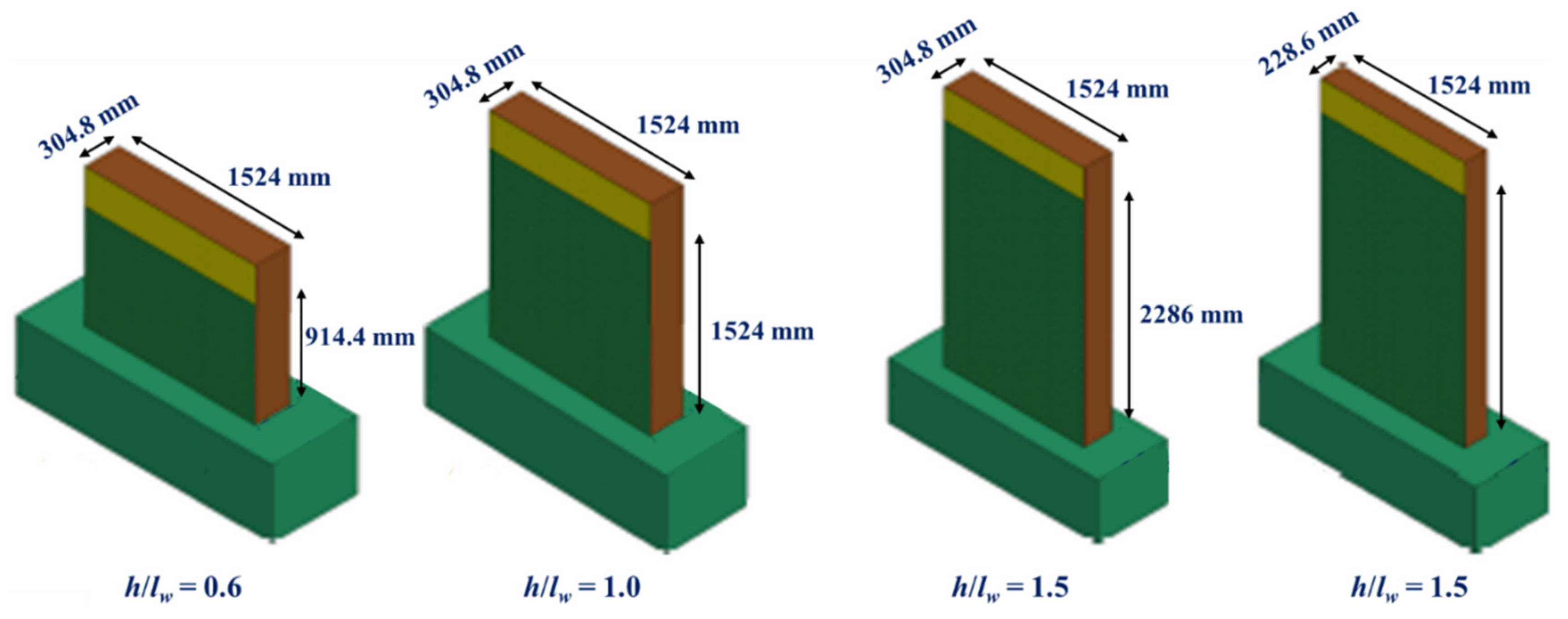

| Specimen | Connection Type | Aspect Ratio, h/lw | Kinitest, kN/mm | Ksectest, kN/mm | Vntest, kN | Drift Ratio, % |
|---|---|---|---|---|---|---|
| SCRC1 | Over-strength | 0.6 | 893.1 | 315.2 | 2179.6 | 1.3 |
| SCRC2 | Over-strength | 0.6 | 718.0 | 332.7 | 2713.4 | 1.7 |
| SC8 | Full-strength | 0.6 | 910.7 | 665.5 | 3113.8 | 1.2 |
| Case No. | h (mm) | lw (mm) | Tsc (mm) | h/lw | ρsc (%) | Rebar Size | No. of Rebars | MnRC (kN-m) | MnSC (kN-m) | MnRC/MnSC (%) | Bond Parameter |
|---|---|---|---|---|---|---|---|---|---|---|---|
| 1 | 914.4 | 1524 | 304.8 | 0.6 | 3.1 | # 4 | 30 (2 × 15) | 1369.4 | 2982.8 | 45 | 15 |
| 2 | 914.4 | 1524 | 304.8 | 0.6 | 3.1 | # 5 | 30 (2 × 15) | 2060.8 | 2982.8 | 70 | 12 |
| 3 | 914.4 | 1524 | 304.8 | 0.6 | 3.1 | # 6 | 30 (2 × 15) | 2779.4 | 2982.8 | 90 | 10 |
| 4 | 1524 | 1524 | 304.8 | 1.0 | 3.1 | # 4 | 30 (2 × 15) | 1369.4 | 3186.2 | 43 | 15 |
| 5 | 1524 | 1524 | 304.8 | 1.0 | 3.1 | # 5 | 30 (2 × 15) | 2060.8 | 3186.2 | 65 | 12 |
| 6 | 1524 | 1524 | 304.8 | 1.0 | 3.1 | # 6 | 30 (2 × 15) | 2779.4 | 3186.2 | 88 | 10 |
| 7 | 2286 | 1524 | 304.8 | 1.5 | 3.1 | # 4 | 30 (2 × 15) | 1369.4 | 3389.5 | 40 | 15 |
| 8 | 2286 | 1524 | 304.8 | 1.5 | 3.1 | # 5 | 30 (2 × 15) | 2060.8 | 3389.5 | 60 | 12 |
| 9 | 2286 | 1524 | 304.8 | 1.5 | 3.1 | # 6 | 30 (2 × 15) | 2779.4 | 3389.5 | 80 | 10 |
| 10 | 2286 | 1524 | 228.6 | 1.5 | 4.2 | # 4 | 30 (2 × 15) | 1342.3 | 3254.0 | 42 | 11 |
| 11 | 2286 | 1524 | 228.6 | 1.5 | 4.2 | # 5 | 30 (2 × 15) | 1965.9 | 3254.0 | 61 | 9 |
| 12 | 2286 | 1524 | 228.6 | 1.5 | 4.2 | # 6 | 30 (2 × 15) | 2643.8 | 3254.0 | 82 | 8 |
Publisher’s Note: MDPI stays neutral with regard to jurisdictional claims in published maps and institutional affiliations. |
© 2022 by the authors. Licensee MDPI, Basel, Switzerland. This article is an open access article distributed under the terms and conditions of the Creative Commons Attribution (CC BY) license (https://creativecommons.org/licenses/by/4.0/).
Share and Cite
Kurt, E.G.; Seo, J.; Varma, A.H. SC Wall-to-RC Basemat Over-Strength Connection: Behavior and Design. CivilEng 2022, 3, 503-524. https://doi.org/10.3390/civileng3020030
Kurt EG, Seo J, Varma AH. SC Wall-to-RC Basemat Over-Strength Connection: Behavior and Design. CivilEng. 2022; 3(2):503-524. https://doi.org/10.3390/civileng3020030
Chicago/Turabian StyleKurt, Efe G., Jungil Seo, and Amit H. Varma. 2022. "SC Wall-to-RC Basemat Over-Strength Connection: Behavior and Design" CivilEng 3, no. 2: 503-524. https://doi.org/10.3390/civileng3020030






